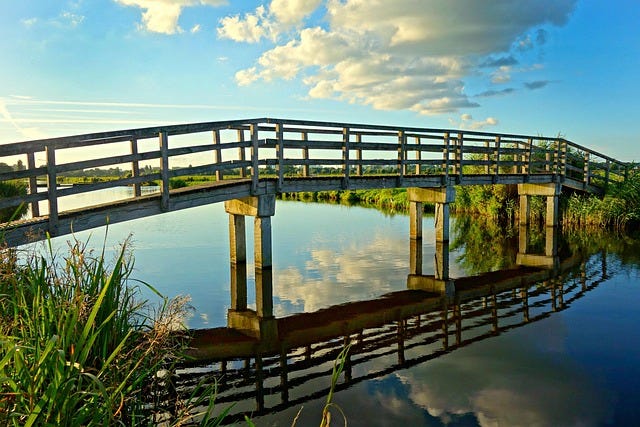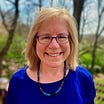Why Building Bridges Is Worth It, Even Now
The role of connection in effective science communication

The Case for Building Bridges
Watching conspiracy theories go viral while careful science gets drowned out, or worse, discredited, can wear down even the most committed communicator. If you’ve felt frustrated, discouraged, or even cynical lately, you’re not alone. We get it, and we’ve felt it too. It's exhausting.
And yet, even in this climate, we choose to build bridges.
Not because it’s easy. But because it works. We are not trying to directly change minds in one conversation. Instead, we aim to communicate in ways that increase the likelihood of our message actually being heard. Research shows that empathy-driven, dialogue-based approaches can reduce polarization, increase trust in science, and make people more open to accurate information.
People tend to interpret information in ways that align with their values and personal identities. This is why sharing facts alone can fall flat, especially if the source isn’t trusted or the information threatens a core identity. While education, debunking, and critical thinking are essential, it’s also important to address the social dynamics that shape whether our perspective is even heard in the first place.
That’s where bridge-building strategies come in. Research shows that structured dialogue, empathy-driven communication, and community engagement can foster trust and reduce polarization, especially when science is seen as distant or threatening to one’s identity. Deliberative forums, citizen science projects, and respectful intergroup contact have been shown to build mutual understanding, shift attitudes, and increase confidence in science. These approaches don’t rely on dumping more facts, but instead emphasize connection, humility, and collaboration, creating space for people to feel heard and respected. When science communication is done with communities rather than at them, trust flourishes.
Empathy is not Endorsement
I love this quote by activist Dylan Marron, and much of his message resonates with our goal here. Choosing to build bridges doesn’t mean validating false information. It doesn’t mean watering down science or pretending that every view holds equal evidence. And it certainly doesn’t mean “both-sides-ing” issues where the facts are clear. What it does mean is recognizing that people are more than their beliefs about science, they’re human. It means we make sure people know we care more about them as a person than whether or not they are vaccinated. And humans are complex, social beings shaped by identity, experience, and information environments.
Empathy isn’t about ignoring false beliefs or blurring the line between opinions and evidence-based information. It’s about understanding the conditions that allow false beliefs to take hold and then working to change those conditions.
Take, for example, a recent dialogue between public health scientists and MAHA (Make America Healthy Again) supporters. Many of the MAHA participants hadn’t even heard about the biomedical research cuts that were under discussion. They weren’t opposed to science, they just hadn’t seen the issue from that angle. Once they had a chance to hear directly from scientists, many agreed: cutting this kind of research doesn’t make America healthier.
What this shows is that skeptics aren’t a monolith. Yes, there are leaders who weaponize distrust for political gain, but there are also people who adopt those views based on personal experience, unmet needs, or simply the limits of the information they’ve been exposed to. Within any group, there’s a wide range of belief and openness to dialogue. It’s critical to distinguish between the few loud, prominent voices that may be purposefully sowing doubt and the everyday people who are genuinely trying to make sense of health information and have adopted those beliefs. Empathy allows us to reach the people who are still reachable, not by endorsing misinformation, but by building the trust that makes honest conversation possible.
So what does bridge-building actually look like in practice? The idea of engaging across divides can feel abstract or even idealistic, especially when tensions run high and trust is low. That’s why it helps to look at real stories of people and organizations doing this work, messy, hopeful, human stories that remind us change doesn’t always happen in grand gestures. Sometimes it begins with a question, a shared concern, or simply the choice to listen first.
Bridge Building Stories Within Public Health
Kristen Panthagani is a physician-scientist and science communicator. Kristen remembers that in 2021, when the COVID vaccines rolled out, she made a special effort to address inaccurate information without any political bent – not attacking politicians who made false statements, not attacking the audience who believed them, and avoiding terms that had become politically polarizing like “misinformation” and “debunk.” Kristen recalls one example of how this helped: “I remember a friend told me she was able to share my articles with a politically conservative friend who said they could ‘actually read this,’ because it didn’t contain many of the political daggers and shame-based messaging that had become common in COVID discourse.”
Beth Malow, a neurologist, and volunteer with the national nonprofit Braver Angels, which works to bridge the political divide in the U.S., recalled attending a Tennessee school board meeting during the COVID-19 pandemic. She had planned to speak in favor of mask mandates but, prior to the meeting, met for coffee with a woman who opposed them. Despite their disagreement, they found common ground in the need for clearer science communication and the importance of good ventilation in schools. That conversation prompted Beth to reconsider the tone of her speech. Rather than framing opponents as "bad people," she rewrote her remarks to avoid shaming those who disagreed.
When she arrived at the meeting, however, it had turned into more of a political rally than a public forum, with signs, chants, and bullhorns opposing mask mandates. Beth was ultimately relieved she didn’t get a chance to speak, especially after learning that a medical professional who spoke in favor of masks was threatened in the parking lot. The incident, which was covered by CNN, left Beth shaken. In the days that followed, she reached out again to the woman she had spoken with before the meeting. That woman strongly condemned the violence and threats, reinforcing the sense of mutual respect and understanding they had begun to build. For Beth, this unexpected connection helped her process the trauma of that evening and reminded her why bridge-building—however difficult—is still worthwhile.
Elisabeth (Liz) Marnik is a PhD-trained scientist and science communicator. She was raised in an anti-science, anti-vaccine household, so she understands firsthand what it feels like to be doubtful and skeptical of scientific information. This background has shaped her approach to science communication—one grounded in empathy and understanding.
Recently, Liz had a breakthrough conversation with her mother, who still holds anti-vaccine beliefs. While discussing the recent rise in measles cases, Liz explained how the measles virus can actually weaken the immune system by erasing its “memory” of past infections, leaving people vulnerable to other diseases even after they recover. Her mom had never heard this before. The two went on to talk about how frightening that reality is for new parents like Liz, who are trying to protect their children. For the first time, her mother acknowledged that vaccinating against measles with the MMR vaccine might make sense, given this newly understood risk. This was a major shift—until then, her mother had never admitted that any vaccine could be beneficial. The conversation marked a small but powerful step forward, built on years of effort and patient dialogue.
Jess Steier is a public health scientist (DrPH) and the founder of Unbiased Science. Working in the policy-heavy world of public health, Jess has her own strongly held beliefs on many subjects, but she constantly reminds herself that effective communication means meeting people where they are, not where she wants them to be. She recognizes that many people, including herself, are products of the environments in which they grow.
Jess doesn’t try to change minds overnight, she focuses on planting seeds through respectful, non-judgmental communication. She often hears from people who feel safe asking questions on her posts without fear of shame, including parents making food choices without guilt, and individuals who felt confident getting vaccinated after reading her clear, empathetic explanations. Even in conversations with libertarian friends whose beliefs often oppose the policy-focused world where she works, Jess finds common ground by connecting as parents and humans. She builds trust by openly acknowledging that science—and her own thinking—has evolved over time, modeling the kind of humility that invites others to stay open too.
Conclusion
Bridge-building isn’t about ignoring hard truths, it’s about finding more effective ways to share them. The stories above show that even in moments of tension or disagreement, connection is possible. And that connection can be powerful. In a polarized world, meeting people where they are with empathy, respect, and a willingness to listen, isn’t just a nice idea; it’s an evidence-based choice. Whether you're leading public health efforts, engaging in science communication, or simply having a difficult conversation in your community, these moments of understanding matter. They remind us that change doesn’t always begin with a debate, it often starts with a relationship. So, let’s keep supporting those doing this work, and challenge ourselves to do it, too. Because building bridges isn’t just idealism; it’s a strategy science outreach can’t afford to ignore.










